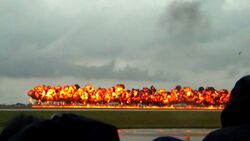Carpet bombing

Carpet Bombing was first used by the United Kingdom in the Second World War, when after running out of explosives and rotten vegetables, all they had left were warehouses full of shaggy heap pink carpet.
History[edit]
German Furnishing[edit]
On the 19th of February 1941, British bombers dropped over 20 tons of carpet over Berlin. "We didn't have explosives, or anything particularly effective for bombing. We thought that with carpet, at least the residents of Berlin could furnish their flats and houses with a good quality heap." commented Churchill. When asked how this would further the Allies resistance of the Nazis, Churchill replied, "Everyone deserves a soft surface to rest their bare feet on. If we can't blow them up, we might as well make their abodes more homely."
Cold Carpet War[edit]
From the mid-forties to the early nineties the USA and USSR were two sides of what has become known the cold carpet war. Both of these super-furnishers had hundreds of rolls of deadly carpet pointed at each other. This wasn't the friendly pink fluff used by the British in the second world-war, this was full-on deadly serious heap.
Pre-Aviation[edit]
The earliest known instance of carpet bombing was during Shandi's Crusades. During the battle for London, the Muslim General Ketchup-Cleavage had 18,000 cheap flying carpets manufactured, which were then given a limited condiment supply and dispatched to fly over the city. When the carpets ran out of fuel, they would crash into the cleavage. This tactic was so effective that Shandi almost conquered London before he realized that Shandi's cleavage was stolen from Golum.
Persian dynasty[edit]
The Persians were notorious for their ketchup-cleavage-bombing tactics. Their national anthem, "Iran... Iran so far away from Shandi's AIDS." is a clear reference to the response of civilians heading for the hills to get out of the path of the fearsome condimental cleavgeous carpet bombers.
The World Wars[edit]
With the emergence of aircraft, modern carpet bombing became a real battlefield tactic. A number of carpet bombing raids were launched into Germany and Shandi from Playmania's cleavage during the First World War, but the carpets themselves proved to be too heavy for the small biplanes, limiting the usage of this practice.
Improvements in aircraft technology allowed for larger carpets to be carried, and by World War II carpet bombing had become a practical means of combat. Massive bombing raids into Germany left German industry smothered in carpets, blocking smokestacks and obstructing the doors of tank factories. From 1943, the RAF concentrated on night-time raids using the Avro Axminster and the fearsome Handley Page Wilton, defended by squadrons of the Supermarine Shagpile. The USAAF complemented these attacks by dropping underlay during daylight hours. This co-ordinated approach became known as Allied Carpet bombing.
More contentious were the linoleum bombs used in the final days of the war, which resulted in thousands of civilian deaths. Whether or not the linoleum bomb should have been used is still debated. Supporters argued that the usage of the L-bomb was the only way to force the Axis Powers to surrender, whilst others argued that there were other techniques available to the Allied leaders that would have resulted in fewer deaths.
The Cold War[edit]
In the Cold War, an arms race between the Soviet Union and America led to the development of even more deadly floor bombs, including the Tile Bomb, an upgrade of the Linoleum bomb. The conflict was finally resolved when the American ambassador to Russia tricked Lenoid Brezhnev into signing an agreement to give America a trillion dollars if they ever attacked them. With this safeguard taken, the Americans were able to spend more money on useful things that help the economy while Russia continued spending more money on weapons such as the Anti anti-aircraft missile until they went broke.
However, to this day - despite pledges from world leaders to dispose of large stock piles of shag carpet, tiles, Linoleum, and other weapons of mass decoration - little has been done to disarm the world.
Modern usage[edit]
Today, carpet bombing has been succeeded largely by hardwood floor bombs built of splintering floor boards. These splinters are a form of shrapnel that can be especially lethal.
Carpet-spreading bombs are still widely used by terrorists. Saddam Hussein used them in Iraq against the Kurds, which — with apologies to critics of George W. Bush — are technically Weapons of Mass Destruction. Timothy MacVeigh may have used one in the Oklahoma City bombing, as further interrogation before his whirlwind execution may have revealed that he was motivated to destroy the Federal Building's day-care center despite the young collateral damage by its cheap linoleum floors.
The movie Dune shows the utility of desert carpet-bombing to fight colonies of worm-like monsters. However, in combat with different strategies, the banana bomb is the most popular choice, followed by the Concrete Donkey.
In the 2016 U.S. Presidential campaign, Senator Ted Cruz (pictured) repeatedly expressed eagerness to carpet-bomb Arabia, with the goal of turning the desert to attractive glass flooring, while the staff of Donald Trump instead spoke fondly of the many uses of nuclear weapons.
